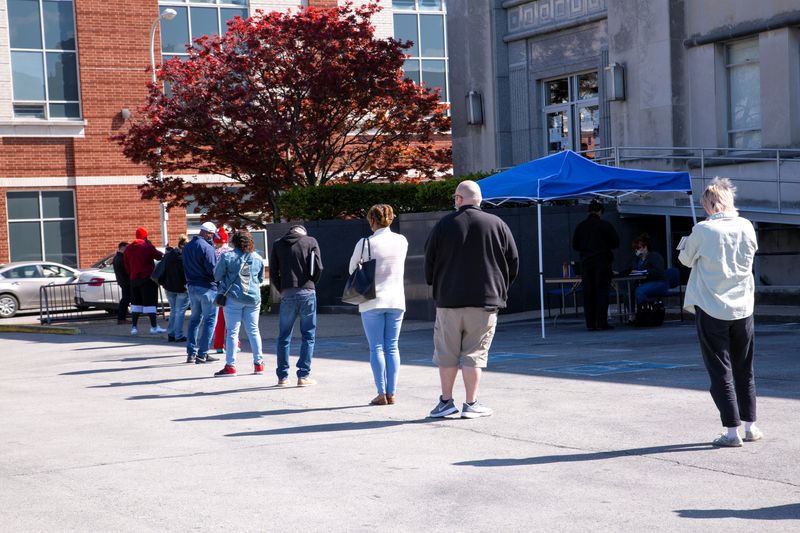By Lucia Mutikani
WASHINGTON (Reuters) - U.S. job openings increased in September, pointing to persistent labor market tightness that is supporting the economy and likely to see the Federal Reserve keeping interest rates higher for a long time to cool demand.
The Job Openings and Labor Turnover Survey, or JOLTS report from the Labor Department on Wednesday also showed layoffs dropping to a nine-month low. There were 1.50 job openings for every unemployed person in September, slightly up from 1.49 in August and way above the pre-pandemic ratio of 1.2.
The U.S. central bank left rates unchanged on Wednesday, but kept the door open to a further increase in borrowing costs as it acknowledged the economy's surprising strength.
"Demand in the overall economy is not slowing down," said Christopher Rupkey, chief economist at FWDBONDS in New York. "The market has taken rate hikes down off the table for this year, but for how long if the labor market remains tight."
Job openings, a measure of labor demand, were up 56,000 to 9.553 million on the last day of September. Data for August was revised lower to show 9.497 million job openings instead of the previously reported 9.610 million. Economists polled by Reuters had forecast 9.250 million job openings in September.
There were an additional 141,000 job openings in the accommodation and food services industry. Unfilled jobs increased 39,000 in the arts, entertainment and recreation sector. But vacancies declined by 124,000 in other services.
Job openings dropped 43,000 in federal government and there were 41,000 fewer open positions in the information industry.
Small businesses accounted for all the unfilled jobs, while companies with 250 to 999 employees reported a big drop.
The job openings rate was unchanged at 5.7%. Hiring increased 21,000 to 5.871 million, indicating that some companies continued to experience difficulties finding workers. The hires rates was unchanged at 3.7%.
Labor market resilience is driving economic growth, keeping a much dreaded recession at bay. Since March 2022, the Fed has raised its policy rate by 525 basis points to the current 5.25%-5.50% range.
Stocks on Wall Street extended gains after the Fed's rate decision and statement. The dollar gained versus a basket of currencies. U.S. Treasury prices were higher, with the yield on the benchmark 10-year Treasury note briefly falling below 4.8% for the first-time in two weeks.
RESIGNATIONS EBB
Layoffs dropped 165,000 to 1.517 million, the lowest level since December 2022. There were notable declines in job losses in construction, manufacturing, professional and business services as well as state and local government education.
Americans are staying put at their jobs, which could help to ease wage inflation. The number of people quitting their jobs fell 2,000 to 3.661 million. The quits rate, viewed as a measure of labor market confidence, was unchanged at 2.3%.
"Quitting activity has normalized to pre-pandemic levels consistent with a tight labor market but companies remain extremely reluctant to fire workers," said Conrad DeQuadros, senior economic advisor at Brean Capital in New York.
While the JOLTS report suggested labor market conditions remained tight, a survey from the Institute for Supply Management (ISM) on Wednesday indicated that companies could be holding back on hiring. The ISM said its measure of factory employment declined sharply in October.
According to the ISM, responses from companies in the survey "indicate a slowdown in hiring," and "an increase in staff reduction activity." It also noted that "attrition, freezes and layoffs to reduce head counts increased during the period, with layoffs the primary tool, indicating a more urgent need to reduce staffing."
But strikes by the United Auto Workers (UAW) union against Detroit's Big Three car makers could also have contributed to the sharp decline in the ISM gauge of factory employment. The ISM's manufacturing PMI dropped to 46.7 in October from 49.0 in September. Economists had forecast the index unchanged at 49.0.
The UAW work stoppages at assembly plants owned by Ford Motor (NYSE:F), General Motors (NYSE:GM) and Chrysler parent Stellantis (NYSE:STLA) across the country, disrupted supply chains and forced automakers to furlough and lay off thousands of non-striking workers. The automakers have since reached tentative agreements with the UAW.
The industrial action likely reduced manufacturing payrolls in October. The government reported last week that there were at least 30,000 UAW members on strike during the period it surveyed business establishments for October's employment report.

According to a Reuters survey of economists factory payrolls likely declined by 10,000 jobs last month after increasing 17,000 in September. That would contribute to lowering overall nonfarm payrolls gains to 180,000 jobs from 336,000 in September. The government will publish October's employment report on Friday.
"The labor market has cooled off from its 2021 highs, but demand for workers is no longer dropping off," said Nick Bunker, director of Economic Research at Indeed Hiring Lab. "The prospects for a 'soft landing' still look good."